SIEMENS KD28VV00 User Manual [fr]
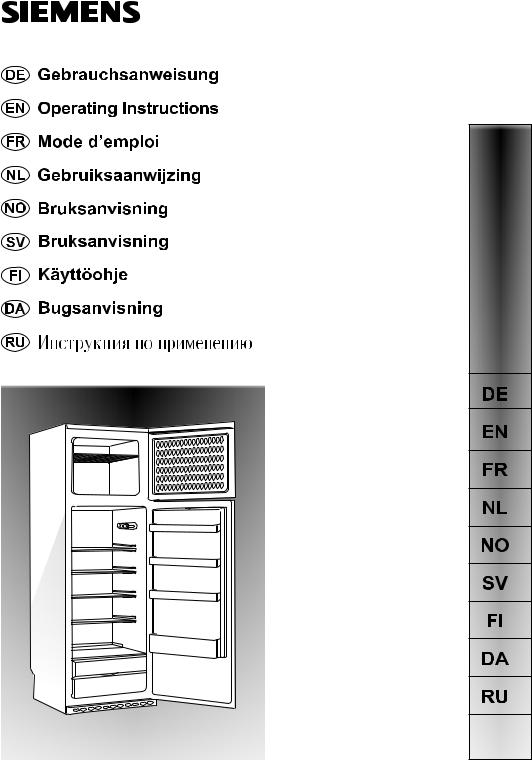
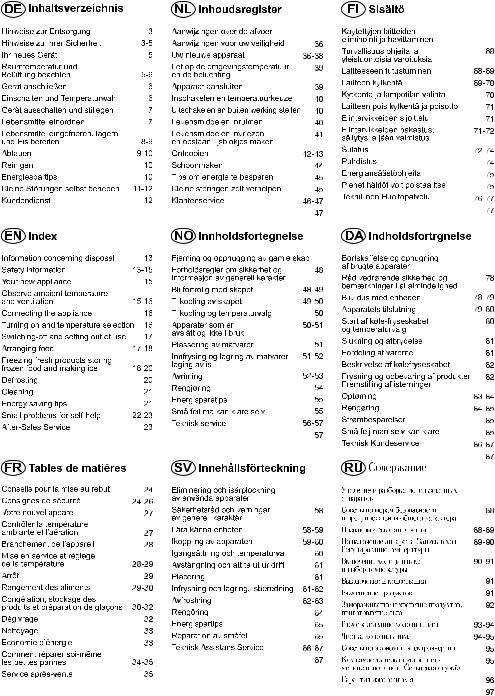

DE.qxd 21/10/05 18:20 Page 3
de
Hinweise zur Entsorgung

 Altgerät entsorgen
Altgerät entsorgen
Bitte beachten, wenn Ihr neues Gerät ein Altgerät ersetzt.
Altgeräte sind kein wertloser Abfall! Durch umweltgerechte Entsorgung können wertvolle Rohstoffe wiedergewonnen werden.
Altgerät unbrauchbar machen:
1.Netzstecker ziehen,
2.Anschlusskabel durchtrennen und mit dem Netzstecker entfernen,
3.Türschloss entfernen, damit spielende Kinder sich nicht einsperren und in Lebensgefahr geraten.
Kältegeräte enthalten Kältemittel und in der Isolierung Gase. Kältemittel und Gase müssen fachgerecht entsorgt werden. Rohre des KältemittelKreislaufes bis zur fachgerechten Entsorgung nicht beschädigen.

 Verpackung entsorgen
Verpackung entsorgen
Achtung:
Verpackungsmaterial ist kein Spielzeug für Kinder – Erstickungsgefahr durch Faltkartons und Folien!
Ihr neues Gerät wurde auf dem Weg zu Ihnen durch die Verpackung geschützt. Alle eingesetzten Materialien sind umwelt-verträglich und wieder verwertbar. Bitte helfen Sie mit: Entsorgen Sie die Verpackung umweltgerecht.
Über aktuelle Entsorgungswege informieren Sie sich bitte bei Ihrem Fachhändler oder bei der Gemeindeverwaltung.
 Dieses Gerät ist entsprechend der europäischen Richtlinie 2002/96/EG über Elektround Elektronikaltgeräte (waste electrical and electronic equipment - WEEE) gekennzeichnet. Die Richtlinie gibt den Rahmen für eine EU-weit gültige Rücknahme und Verwertung der Altgeräte vor.
Dieses Gerät ist entsprechend der europäischen Richtlinie 2002/96/EG über Elektround Elektronikaltgeräte (waste electrical and electronic equipment - WEEE) gekennzeichnet. Die Richtlinie gibt den Rahmen für eine EU-weit gültige Rücknahme und Verwertung der Altgeräte vor.
Hinweise zu Ihrer Sicherheit
Bevor Sie das Gerät in Betrieb nehmen
Lesen Sie Gebrauchsund Montageanleitung aufmerksam durch! Sie enthalten wichtige Informationen über Aufstellen, Gebrauch und Wartung des Gerätes.
Der Hersteller haftet nicht, wenn Sie die Hinweise und Warnungen der Gebrauchsanweisung missachten.
Bewahren Sie Gebrauchsund Montageanweisung für einen Nachbesitzer auf.
 Warnungen
Warnungen
•Das Gerät enthält in geringer Menge das umweltfreundliche, aber brennbare Kältemittel R600a. Achten Sie darauf, dass die Rohre des KältemittelKreislaufes bei Transport oder Montage nicht beschädigt werden. Herausspritzendes Kältemittel kann zu Augenverletzungen führen oder sich entzünden.
Wenn Kältemittel austritt, darauf achten:
–dass kein offenes Feuer oder Zündquellen in der Nähe sind.
–Netzstecker ziehen, Raum für einige Minuten gut durchlüften.
3
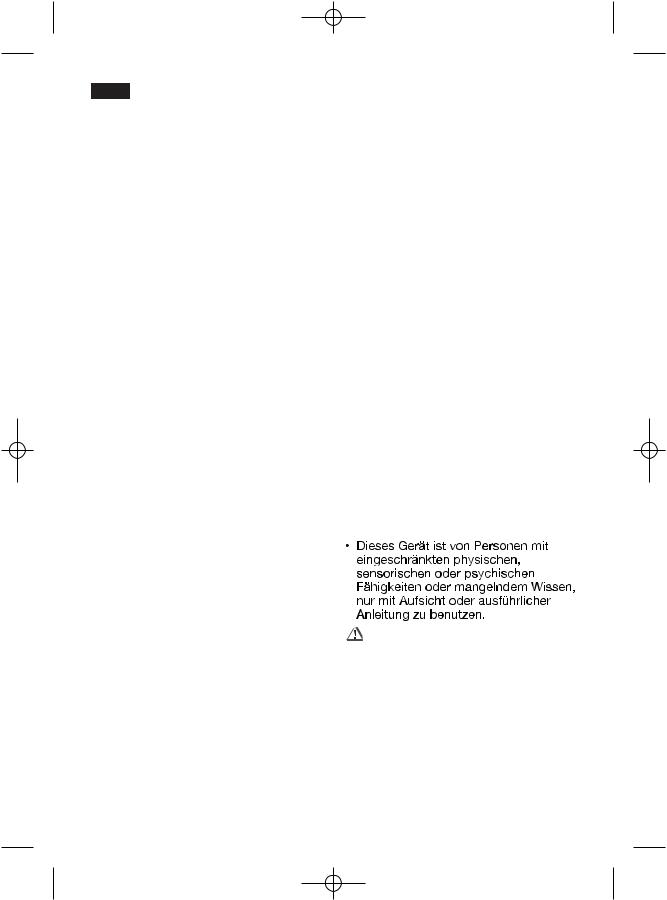
DE.qxd 21/10/05 18:20 Page 4
de
•Je mehr Kältemittel in einem Gerät ist, umso größer muss der Raum sein,
in dem das Gerät steht. In zu kleinen Räumen kann bei einem Leck ein brennbares Gas-Luft-Gemisch entstehen.
•Pro 8 g Kältemittel muss der Raum mindestens 1 m3 groß sein. Die Menge des Kältemittels Ihres Gerätes steht auf dem Typschild im Inneren des Gerätes.
•Bei Notfällen
–Augen ausspülen und Arzt aufsuchen.
–Zündfunken und offenes Feuer vom Gerät fernhalten.
–Netzstecker ziehen, Raum einige Minuten gut lüften.
•In folgenden Fällen Netzstecker ziehen oder Sicherung ausschalten
–Abtauen
–Reinigen
Am Netzstecker ziehen, nicht am Anschlusskabel.
•Beschädigte oder defekte Geräte nicht in Betrieb nehmen. Im Zweifelsfall beim Händler erkundigen.
•Nie elektrische Geräte innerhalb des Gerätes verwenden (z. B. Heizgeräte, elektrische Eisbereiter usw.)
•Keine Produkte mit brennbaren Treibgasen (z. B. Spraydosen) und keine explosiven Stoffe lagern - Explosionsgefahr!
•Das Gerät ist kein Spielzeug für Kinder!
•Nie das Gerät mit einem Dampfreinigungsgerät abtauen oder reinigen! Der Dampf kann an elektrische Teile gelangen und einen Kurzschluss oder einen Stromschlag auslösen.
Beim Gebrauch beachten
•Beund Entlüftungsöffnungen niemals abdecken oder zustellen!
•Nur Fachkräfte dürfen Reparaturen durchführen. Unsachgemäße Reparaturen können den Benutzer erheblich gefährden.
•Sockel, Auszüge, Türen usw. nicht als Trittbrett oder zum Abstützen miss-brauchen.
•Hochprozentigen Alkohol nur dicht verschlossen und stehend lagern.
•Bei Gerät mit Türschloss: Schlüssel außer Reichweite von Kindern aufbewahren!
•Kunststoff-Teile und Türdichtung nicht mit Öl oder Fett verschmutzen. Kunst-stoff- Teile und Türdichtung werden sonst porös.
•Im Gefrierraum keine Flüssigkeiten in Flaschen und Dosen lagern (besonders kohlensäurehaltige Getränke). Flaschen und Dosen platzen!
•Eis am Stiel und Eiswürfel nicht sofort vom Gefrierraum in den Mund nehmen.
Gefrierverbrennungsgefahr durch sehr tiefe Temperatur!
•Gefriergut nicht mit nassen Händen berühren. Die Hände können daran festfrieren!
•Reifschicht und festgefrorenes Gefriergut nicht mit Messer oder spitzem Gegenstand abschaben. Sie könnten damit die Kältemittelrohre beschädigen. Herausspritzendes Kältemittel kann sich entzünden oder zu Augenverletzungen führen.
•Zum Beschleunigen des Abtauvorgangs nur vom Hersteller empfohlene Mittel benutzen.
Warnung
•Die Lüftungsschlitze in der Kühlschrankstruktur dürfen nicht verdeckt werden.
•Zur Beschleunigung des Abtauvorgangs dürfen nur mechanische Hilfsmittel oder andere Mittel verwendet werden, die vom Hersteller empfohlen werden.
•Achten Sie darauf, dass der Kühlkreislauf nicht beschädigt wird.
4
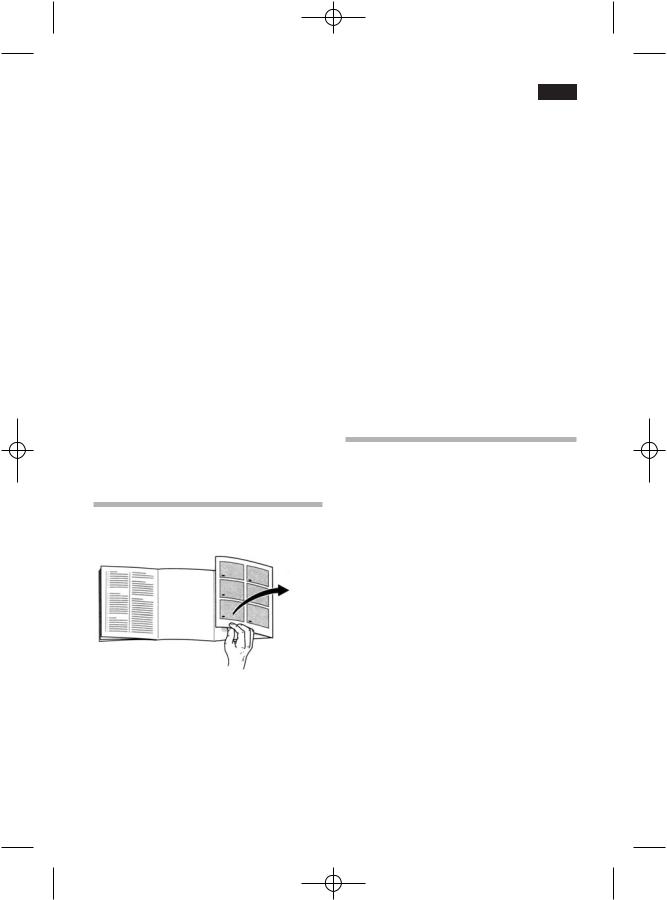
DE.qxd 21/10/05 18:20 Page 5
•Für den Kühl-/Gefrierschrank nur die vom Hersteller empfohlenen internen elektrischen Komponenten verwenden.
Allgemeine
Bestimmungen
Das Gerät eignet sich
•zum Kühlen und Gefrieren von Lebensmitteln,
•zur Eisbereitung.
Das Gerät ist für die Verwendung im Haushalt bestimmt.
Beim gewerblichen Einsatz gelten die entsprechenden Normen und Vorschriften.
Das Gerät ist funkentstört nach EURichtlinie 89/336/EEC.
Der Kältekreislauf ist auf Dichtheit geprüft.
Dieses Erzeugnis entspricht den einschlägigen Sicherheitsbestimmungen für Elektrogeräte (EN 60335/2/24).
Ihr neues Gerät
Detailabweichungen – insbesondere bei
Ausstattungsmerkmalen – je nach
Gerätetyp.
de
Bild Q
1Eisschale
2Temperaturwähler und Innenbeleuchtung
3Traggitter
4Fleischbehälter
5Tauwasserablaufrinne
6Platte
7Gemüseschale
8Belüftungsgitter im Sockel
9Behälter
10große Absteller
11Türdichtung
22 Gefrierschalter (Bild E)
AGefrierabteil
BKühlraum
Raumtemperatur und Belüftung beachten
Die Klimaklasse steht auf dem Typenschild (Bild !0). Sie gibt an, innerhalb welcher Raumtemperaturen das Gerät betrieben werden kann.
Klimaklasse |
zulässige Raum- |
|
temperatur |
SN |
+10 °C bis 32 °C |
N |
+16 °C bis 32 °C |
ST |
+16 °C bis 38 °C |
T |
+16 °C bis 43 °C |
|
|
5

DE.qxd 21/10/05 18:20 Page 6
de
Belüftung
Die Luft an der Rückwand des Geräts erwärmt sich. Die erwärmte Luft muss ungehindert abziehen können. Die Kühlmaschine muss sonst mehr leisten. Dies erhöht den Stromverbrauch. Daher: Nie Beund Entlüftungsöffnungen abdecken oder zustellen!
Nutzinhalt
Die Angaben zum Nutzinhalt finden Sie in Ihrem Gerät auf dem Typenschild.
Gerät anschließen
Nach dem Aufstellen des Gerätes sollte man mind. 1/2 Std. warten, bis das Gerät in Betrieb genommen wird. Während des Transports kann es vorkommen, dass sich das im Verdichter enthaltene Öl im Kältesystem verlagert.
Vor der ersten Inbetriebnahme den Innenraum des Gerätes reinigen (siehe Reinigen).
Die Steckdose sollte frei zugänglich sein. Das Gerät an 220–240 V/50 Hz Wechselstrom über eine vorschriftsmäßig installierte Steckdose anschließen. Die Steckdose muss mit einer 10-A-Sicherung oder höher abgesichert sein.
Bei Geräten, die in nicht-europäischen Ländern betrieben werden, ist auf dem Typschild zu überprüfen, ob die angegebene Spannung und Stromart mit den Werten Ihres Stromnetzes übereinstimmt. Das Typschild befindet sich im Gerät links unten. Ein eventuell notwendiger Austausch der Netzanschlussleitung darf nur durch einen Fachmann erfolgen.
Einschalten und Temperaturwahl
Vor der ersten Inbetriebnahme den Innenraum reinigen (siehe Reinigen).
Gerät einschalten
Temperaturwähler (Bild E) aus der „O"-Stellung herausdrehen.
Das Gerät beginnt zu kühlen.
Sollte sich nach dem Schließen des Gefrierabteils die Tür nicht sofort wieder öffnen lassen, warten Sie bitte zwei bis drei Minuten, bis sich der entstandene Unterdruck ausgeglichen hat.
Temperatur einstellen
Die temperaturen in den beiden Räumen können Sie zentral über den Temperaturwähler (Bild E) einstellen. Höhere Ziffern ergeben in beiden Räumen tiefere Temperaturen.
Bei TemperaturwählerStellung „O” ist die Kühlung abgeschaltet, von „1” an nimmt die Kühlung zu.
Wir empfehlen eine mittlere Einstellung (ca. „2-3”).
Zum Eingefrieren frischer Lebensmittel Temperaturwähler auf „3” drehen (siehe auch „Lebensmittel gefrieren").
Bei Lagerung von Gefriergut beachten
Sinkt die Temperatur des Raumes in dem das Gerät steht unter + 18ºC ab, ist der Wippschalter einzuschalten (rote Markierung wird sichtbar) Bild (E/22). Wenn Sie dies tun, brennt die Kühlschrankbeleuchtung ständig mit geminderter Leistung. Dies bewirkt, dass die für die Langzeitlagerung erforderliche Temperatur im Gefrierteil beibehalten wird.
6

DE.qxd 21/10/05 18:20 Page 7
de
Gerät ausschalten und stillegen
Gerät ausschalten
Temperaturwähler (BildE) auf „O"- Stellung drehen, damit ist die Kühlung des gesamten Gerätes ausgeschaltet.
Gerät stillegen
Wenn das Gerät längere Zeit nicht benutzt wird, Netzstecker ziehen, Gerät abtauen und reinigen. Türen offen lassen.
Lebensmittel einordnen
Inneneinrichtung verändern
Die Traggitter im Kühlraum können bei Bedarf umgesetzt werden. Zum Umsetzen Traggitter nach vorne ziehen, absenken und an gewünschter Stelle neu einsetzen. Bild R
Zum Lagern von Flaschen kann das Traggitter schräg eingesetzt werden.
Die Absteller in der Innentür können zum Reinigen abgenommen werden (Bild Y).
Bei dem Einordnen beachten
•Warme Speisen und Getränke außerhalb des Gerätes abkühlen lassen.
•Lebensmittel möglichst verpackt oder gut abgedeckt einordnen.
•Öl und Fett nicht mit den Kunststoffteilen und der Türdichtung in Berührung bringen (diese könnten sonst porös werden).
•Im Gerät keine explosiblen Stoffe aufbewahren.
•Hochprozentigen Alkohol nur verschlossen, stehend lagern.
•Im Kühlraum befinden sich die kältesten Bereiche an der Rückwand und über der untersten Ablage.
Einordnungsbeispiel
Bild Q
Im Gefrierabteil (A), Lebensmittel einfrieren, lagern und Eis bereiten.
Auf den Traggittern (3),
von oben nach unten Backwaren, fertige Speisen, Molkereiprodukte. Im Fleischbehälter (4),
Fleisch und Wurst.
Auf der untersten Ablage (6), Fleisch und Wurst.
In der Gemüseschale (7), Gemüse, Obst, Salat.
In der Tür in den Behältern (9), Tuben und kleine Dosen.
In den Abstellern (10), große Flaschen.
Kältezonen im Kühlraum beachten!
Durch die Luftzirkulation im Kühlraum entstehen Zonen unterschiedlicher Kälte.
Die Zone für empfindliche Lebensmittel ist je nach Modell, ganz unten zwischen dem seitlichen eingeprägten Pfeil und der darunter liegenden Glasablage (Bild !1/1 und 2) oder zwischen den beiden Pfeilen (Bild !2/1 und 2)
Ideal zum Lagern von Fleisch, Fisch, Wurst, Salatmischungen usw.
7

DE.qxd 21/10/05 18:20 Page 8
de
Lebensmittel eingefrieren, lagern und Eis bereiten
Beim Kauf von Tiefkühlkost beachten
•Achten Sie auf die Verpackung, sie sollte nicht beschädigt sein.
•Das Haltbarkeitsdatum darf nicht überschritten sein.
•Die Temperaturanzeige von der Verkaufstruhe sollte -18º C oder kälter anzeigen.
•Tiefkühlkost ganz zum Schluß einkaufen und gut eingepackt in Zeitungspapier oder in einer Kühltasche schnell nach Hause transportieren und in das Gefrierabteil legen.
Lebensmittel verpacken
Werden Lebensmittel selbst eingefroren,
nur frische einwandfreie Lebensmittel verwenden. Die Lebensmittel luftdicht verpacken, damit sie nicht ihren Geschmack verlieren oder austrocknen.
Zum Verpacken geeignet sind:
Kunststoff-Folien, Schlauchfolien aus Polyäthylen, Alu-Folien und Gefrierdosen. Diese Produkte finden Sie im Fachhandel.
Ungeeignet sind:
Packpapier, Pergamentpapier, Cellophan, Müllbeutel und gebrauchte Einkaufstüten.
Die Lebensmittel in die Verpackung einlegen, Luft völlig herausdrücken und Packung dicht verschließen.
Zum Verschließen eignen sich:
Gummiringe, Kunststoffklipse, Bindfäden, kältebeständige Klebebänder oder ähnliches. Beutel und Schlauchfolien aus Polyäthylen können mit einem Folienschweißgerät verschweißt werden.
Vor dem Einlegen in das Gefrierteil, den lnhalt der Gefrierpakete kennzeichnen und mit dem Einlegedatum versehen.
Gefriervermögen
Angaben über das max. Gefriervermögen nach aktueller Norm finden Sie auf dem Typschild.
Die maximale Gefrierkapazität für frische Lebensmittel innerhalb von 24 Stunden (die auf den Gefrierrosten verteilt liegen) ist auf dem Typenschild (in kg/24 Std) angegeben. Siehe Abbildung !0.
Legen Sie die zu gefrierenden Lebensmittel breitflächig auf den Boden des Gefrierabteils. Achten Sie bitte darauf, daß bereits gefrorene und frisch einzufrierende Lebensmittel nicht miteinander in Berührung kommen.
Temperaturwähler zum Gefrieren einstellen und Gefrierschalter einschalten
Beim Einlegen frischer re den Temperaturwähler auf eine mittlere Einstellung (ca. „3”) drehen. Bei dieser Einstellung können bis zu 2,5 kg Lebensmittel gefroren werden. Bei größeren Mengen zusätzlich den Gefrierschalter (bild E/22) betätigen (Wippschalter drücken -rote Markierung wird sichtbar). Ca. 24 Stunden nach dem Einlegen der Lebensmittel ist der Gefriervorgang beendet, der Gefrierschalter kann wieder ausgeschalter werden.
8

DE.qxd 21/10/05 18:20 Page 9
Beim Einlegen von Gefriergut beachten
Bereits gefrorene Lebensmittel dürfen nicht mit den frisch einzufrierenden Lebensmitteln in Berührung kommen.
Bei Lagerung von Gefriergut beachten
Sinkt die Temperatur des Raumes in dem das Gerät steht unter +18ºC ab, ist der Wippschalter einzuschalten (rote Markierung wird sichtbar) Bild (E/22). Wenn Sie dies tun, brennt die Kühlschrankbeleuchtung ständig mit geminderter Leistung. Dies bewirkt, dass die für die Langzeitlagerung erforderliche Temperatur im Gefrierteil beibehalten wird.
Lagerdauer
Um Qualitätsminderungen des Gefriergutes zu vermeiden, ist es wichtig, daß die zulässige Lagerdauer nicht überschritten wird. Die Lagerdauer richtet sich nach der Art der Lebensmittel. Bei -18ºC können Fisch, Wurst, fertige Speisen und Backwaren bis zu 2 Monate, Käse, Geflügel, Fleisch bis zu 4 Monate und Gemüse und Obst bis zu 6 Monate gelagert werden.
Auftauen von Gefriergut
Je nach Art und Verwendungszweck kann zwischen folgenden Möglichkeiten gewählt werden:
Bei Raumtemperatur, im Kühlschrank,
im elektrischen Backofen, mit/ohne Heißluftventilator, im Mikrowellengerät.
Anund aufgetautes Gefriergut kann erneut eingefroren werden, wenn Fleisch und Fisch nicht länger als einen Tag, anderes Gefriergut nicht länger als drei Tage über 3º C angestiegen ist.
de
Andernfalls, wenn Geschmack, Geruch und Aussehen unverändert sind, durch Kochen, Braten oder zu einem Fertiggericht weiter-verarbeiten und erneut eingefrieren.
Die max.Lagerdauer nicht mehr voll nutzen.
Eis bereiten
Bild U
Stellen Sie die zu 3/4 mit Wasser gefüllte Eisschale auf den Boden des Gefrierabteiles. Die gefrorenen Eiswürfel lassen sich durch Verwinden der Eisschale leicht lösen.
Abtauen
Kühlraum
Der Kühlraum taut vollautomatisch ab. Das Tauwasser wird in die Tauwasserablaufrinne (Bild I/7) aufgefangen, zur Kühlmaschine geleitet und dort verdunstet. Ablaufrinne und Ablaufloch (bild I/19) stets sauber halten damit das Tauwasser ungehindert abfließen kann.
Gefrierabteil
Das Gefrierabteil (Bild Q/A) taut nicht automatisch ab, da die gefrorenen Lebensmittel nicht antauen dürfen.
Die Reifoder Eisschicht verschlechtert die Kälteabgabe an das Gefriergut und läßt den Stromverbrauch ansteigen.
Reifschicht abschaben
Zum Entfernen der Reifschicht einen Reifschaber verwenden. Das Gefrierabteil darf auf keinen Fall beschädigt werden, deshalb keine spitzen oder scharfkantigen Metallgegenstände verwenden.
9

DE.qxd 21/10/05 18:20 Page 10
de
Eisschicht abtauen
Wenn das Gefrierabteil stark vereist ist sollte es abgetaut werden. Wenn noch Gefriergut im Gerät lagert, ist ca. 4 Stunden vor dem Abtauen der Gefrierschalter Bild E/22 einzuschalten, damit die Lebensmittel eine sehr tiefe Temperatur erreichen. Danach die Gefriergutschalen mit den Lebensmittleln herausnehmen.
Gehen Sie wie folgt vor:
•Gefriergut entnehmen, in Zeitungspapier wickeln und an einem kühlen Ort lagern.
•Temperaturwähler (Bild Q/2) auf „O” drehen oder Netzstecker ziehen. arauf achten, daß kein Tauwasser in den Temperaturwähler gelangt.
•Tür offen lassen, Tauwasser mit Tuch oder Schwamm aufwischen.
•Gefrierabteil trockenreiben, Gerät wieder inschalten und Gefriergut einlegen.
Abtauhilfen
Vorsicht bei Verwendung von Abtausprays, diese können explosible Gase bilden, kunststoffschädigende Lösungsoder Treibmittel enthalten oder gesundheitschädlich sein. Achten Sie auf die Herstellerangaben.
Reinigen
Vor dem Reinigen grundsätzlich Netzstecker ziehen bzw. Sicherung abschalten oder herausschrauben.
Zur Reinigung des gesamten Gerätes außer der Türdichtung eignet sich lauwarmes Wasser mit etwas Spülmittel.
Ungeeignet sind sandoder säurehaltige Putzmittel und Lösungsmittel.
Die Türdichtung (Bild Q/11) nur mit klarem Wasser abwischen und danach gründlich trockenreiben.
Darauf achten, daß kein Reinigungswasser in den Temperaturwähler (Bild Q/2) gelangt.
Ablaufrinne (Bild I/7) und Ablaufloch (Bild I/19) im Kühlraum häufiger reinigen, damit das Tauwasser ungehindert ablaufen kann. Ablauföffnungen mit Stäbchen o.ä. durchstoßen. Darauf achten, daß möglichst kein Reinigungswasser durch die Ablauföffnung in die Verdunstungsschale läuft.
Die Außenwände können zusätzlich mit einem Lackpflegemittel behandelt werden. Die Tür dabei geschlossen lassen, damit das Lackpflegemittel nicht an die inneren Kunststoffteile gelangen kann.
Energiespartips
•Gerät in einem kühlen gut belüftbaren Raum aufstellen, vor direkter Sonnenbestrahlung schützen und nicht im Bereich einer Wärmequelle (Heizkörper etc) anordnen.
•Warme Speisen erst nach dem Abkühlen in das Gerät geben.
•Zum Auftauen Gefrierwaren in den Kühlraum legen. Sie nutzen damit die kälte, die in der Gefrierware steckt, zu Kühlung der Lebensmittel im Kühlraum.
•Gefrierabteil bei Eisbildung abtauen. Eine dicke Eisschicht verschlechtert die Kälteabgabe an das Gefriergut un läßt den Stromverbrauch ansteigen.
•Zum Beoder Entladen, Gerätetür so kurz wie möglich öffnen.
10

DE.qxd 21/10/05 18:20 Page 11
de
Kleine Störungen selbst beheben
Bevor Sie den Kundendienst rufen, prüfen Sie bitte, ob Sie aufgrund der nachfolgenden Aufstellung die Störung selbst beheben können.
Bei Beratungsfällen müssen Sie, auch während der Garantiezeit, die vollen Kosten für den Monteureinsatz übernehmen.
Störungen |
Mögliche Ursachen |
Bei ungewöhnlichen Geräuschen: |
- Entweder steht das Gerät nicht fest bzw. |
|
eben oder ein Fremdkörper ist im Bereich |
|
der Kühlmaschine eingeklemmt. |
|
- Ein Teil an der Rückwand kann nicht frei |
|
schwingen und berührt das Gerät oder die |
|
Wand, biegen Sie dieses Teil vorsichtig weg. |
|
|
Wenn die Kühlraum-Beleuchtung |
- Die Glühlampe ist defekt. Netzstecker |
nicht funktioniert: |
ziehen, Abdeckung Bild O abnehmen. |
|
Glühlampe max. 15W, 220-240V, Sockel E |
|
14 auswechseln. |
|
- Der Lichtschalter (Bild T/1) klemmt. Prüfen |
|
Sie, ob er sich bewegen läßt. Wenn nicht, |
|
rufen Sie bitte den Kundendienst. |
|
- Der Temperaturwähler (Bild O/3) steht „O”. |
|
|
Im Kühlraum zu kalt: |
- Temperaturwähler ist zu tief eingestellt. |
|
- Der Geifrierschalter Bild E/22 wurde beim |
|
Einlegen frischer Lebensmittel nicht |
|
eingeschaltet. |
|
|
Kühlleistung läßt nach: |
- Tür wurde häufig geöffnet. |
|
- Es wurden große Mengen Lebensmittel im |
|
Kühlraum frisch eingelagert. |
|
- Zu starke Reifschicht im Gefrierabteil. |
|
- Die Beund Entlüftung ist abgedeckt. |
|
- Ein Fremdkörper ist zwischen Kühlmaschine |
|
und der Wand eingeklemmt. |
|
|
Keine Kühlleistung: |
- Stecker ist lose in der Steckdose, |
|
- Sicherung hat ausgelöst, |
|
- Temperaturwähler (Bild Q/2) steht auf „O". |
11

DE.qxd 21/10/05 18:20 Page 12
de
Kleine Störungen selbst beheben
Kann die Störung anhand der zuvor genannten Hinweise nicht beseitigt werden, rufen Sie bitte den Kundendienst.
Führen Sie in diesem Fall keine weiteren Arbeiten, vor allem an den elektrischen Teilen des Gerätes, selbst aus.
Öffnen Sie die Tür nicht unnötig oft, damit Kälteverlust vermieden wird.
Kundendienst
Typenschild
Abbildung !0
Wenn Sie sich an den zuständigen Kundendienst wenden, so geben Sie bitte stets die Gerätenummer (23) und die Herstellnummer (24) an. Beide Angaben finden Sie schwarz eingerahmt auf dem Typenschild.
Das Typenschild selber befindet sich im Inneren des Kühlschranks und zwar links von den Obstund Gemüseschalen.
Die Anschrift und Telefonnummer lhres zuständigen Kundendienstes finden Sie in unserer Kundendienstaufstellung oder aber im örtlichen Telefonbuch.
12

EN.qxd 21/10/05 18:21 Page 13
en
Information concerning disposal

 Disposal of your old appliance
Disposal of your old appliance
When replacing your old appliance with a new one, please comply with the following:
Old appliances are not worthless rubbish! Valuable raw materials can be reclaimed by recycling old appliances.
Render your old appliance unusable:
1.Pull out the mains plug.
2.Cut off the power cord and discard with the mains plug.
3.Remove the lock to prevent children from locking themselves in the refrigerator and suffocating.
Refrigerators contain refrigerants and the insulation contains gases. Refrigerant and gases must be disposed of properly. Ensure that tubing of the refrigerant circuit is not damaged prior to proper disposal.

 Disposal of packaging
Disposal of packaging
Warning:
Keep children away from packaging materials. Danger of suffocation from folding cartons and plastic film!
You received your new appliance in a protective shipping carton. All
packaging materials are environmentally friendly and recyclable. Please contribute to a better environment by disposing of packaging materials in an environmentally-friendly manner.
Please ask your dealer or inquire at your local authority about current means of disposal.
 This appliance is labelled in accordance with European Directive 2002/96/EG concerning used electrical and electronic appliances (waste electrical and electronic equipment - WEEE). The guideline determines the framework for the return and recycling of used appliances as applicable throughout the EU.
This appliance is labelled in accordance with European Directive 2002/96/EG concerning used electrical and electronic appliances (waste electrical and electronic equipment - WEEE). The guideline determines the framework for the return and recycling of used appliances as applicable throughout the EU.
Safety information
Before you switch ON the appliance
Please read the operating and installation instructions carefully. They contain important information on how to install, use and maintain the appliance.
The manufacturer is not liable if you fail to comply with the instructions and warnings. Please retain these operating and installation instructions as they may be required by a subsequent user of the appliance.
 Warnings
Warnings
•This appliance contains a small quantity of environmentally-friendly but flammable R600a refrigerant. Ensure that the tubing of the refrigerant circuit is not damaged during transportation and installation. Leaking refrigerant may cause eye injuries or ignite.
If refrigerant is escaping, ensure that:
–there are no naked flames or ignition sources in the vicinity.
–Pull out the mains plug and ventilate the room for several minutes.
•The more refrigerant an appliance contains, the larger the room must be. Leaking refrigerant can form a flammable gas-air mixture in rooms which are too small.
13
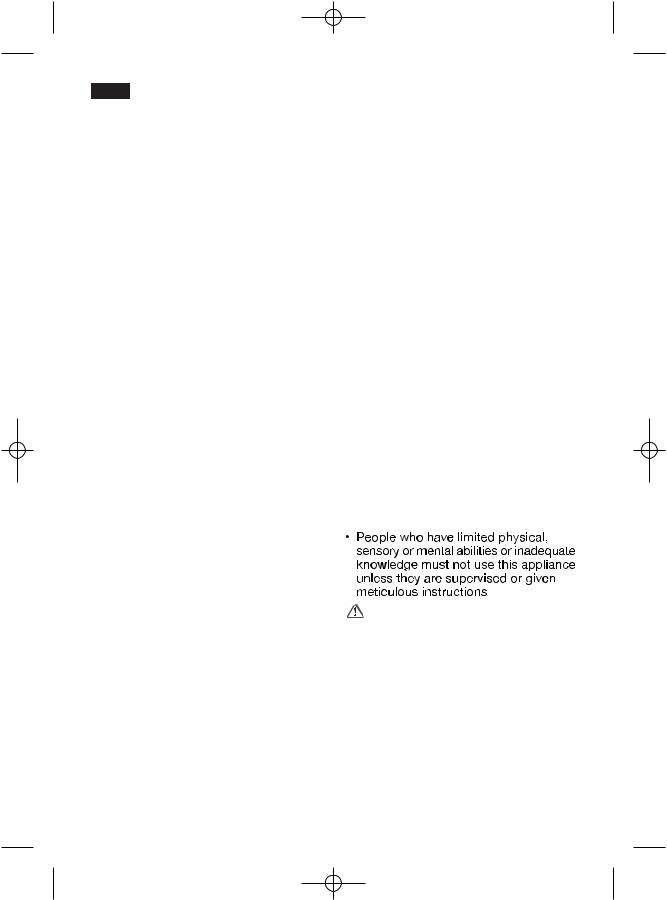
EN.qxd 21/10/05 18:21 Page 14
en
•The room must be at least 1 m3 per 8 g of refrigerant. The amount of refrigerant in your appliance is indicated on the rating plate inside the appliance.
•In an emergency
–Rinse eyes and call a doctor.
–Keep ignition sources and naked flames away from the appliance.
–Pull out the mains plug and ventilate the room for several minutes.
•In the following cases pull out the mains plug or switch off the fuse.
–Defrosting
–Cleaning
Do not pull out the mains plug by tugging the cable.
•Do not switch on damaged or defective appliances. If in doubt, contact your dealer.
•Never use electrical appliances inside the refrigerator (e.g. heater, electric ice maker, etc.).
•Do not store products which contain flammable propellants (e.g. spray cans) or explosive substances in the appliance – Risk of explosion!
•Do not allow children to play with the appliance!
•NEVER use a steam cleaner to defrost or clean the appliance. Steam may come into contact with electrical components and cause a short-circuit or an electric shock.
When using the appliance, comply with the following:
•Never cover or block the ventilation openings!
•Repairs may be performed by qualified technicians only. Improper repairs may put the user in considerable danger.
•Do not stand or support yourself on the base, drawers or doors, etc.
•Bottles which contain a high percentage of alcohol must be sealed and stored in an upright position.
•If the appliance features a lock, keep the key out of the reach of children.
•Keep plastic parts and the door seal free of oil and grease. Otherwise, parts and door seal will become porous.
•Do not store bottled or canned drinks (especially carbonated drinks) in the freezer compartment. Bottles and cans will explode.
•Do not put an ice lolly or ice cube directly from the freezer compartment into your mouth. Risk of burns from very low temperatures!
•Never touch frozen food with wet hands. Your hands could freeze to the food!
•Do not scrape off hoarfrost or stuck frozen food with a knife or pointed object. You could damage the refrigerant tubing. Leaking refrigerant may ignite or cause eye injuries.
•Use only agents recommended by the manufacturer to accelerate the defrosting process.
Important
•Do not block the ventilation grilles on the refrigerator casing.
•Do not use mechanical devices or any other method to accelerate the thawing-out process, other than those recommended by the manufacturer.
•Do not damage the refrigeration circuit.
•Always use the internal electrical components recommended by the manufacturer for your refrigerator/freezer.
14
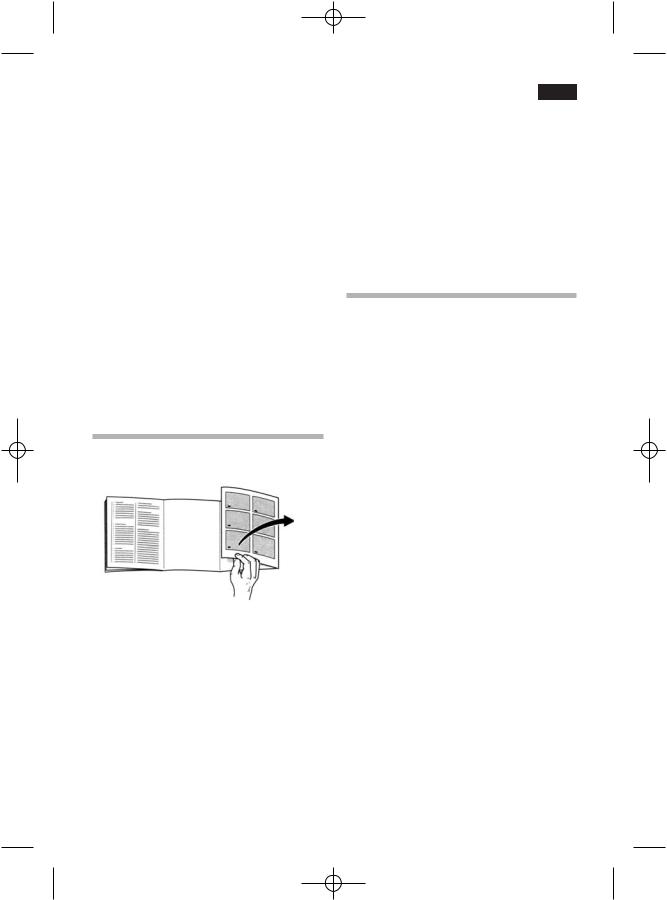
EN.qxd 21/10/05 18:21 Page 15
General requirements
The appliance is suitable
•for refrigerating and freezing food,
•for making ice.
The appliance is designed for domestic use.
If the appliance is used industrially, the appropriate standards and regulations shall apply.
The appliance has been interferencesuppressed in compliance with EU Directive 89/336/EEC.
The refrigerant circuit has been tested for leaks.
This product complies with the relevant safety regulations for electrical appliances (EN 60335/2/24).
Your new appliance
Details may differ according to the appliance type, especially with respect to features.
Fig. Q
1Ice-cube tray
2Temperature selector/inner light
3Racks
4Meat container
5Discharge gutter for thaw-water
6Shelf
en
7Vegetable bin
8Kickstrip with ventilation outlet
9Container
10Big shelf
11Door seal
22 Freezer switch (Fig. E)
ADeep-freezing compartment
BRefrigerator
Observe ambient temperature and ventilation
The climatic class can be found on the rating plate (Fig. !0) and indicates the ambient temperatures at which the appliance can be operated.
Climatic class |
Permitted ambient |
|
temperature |
SN |
+10 °C to 32 °C |
N |
+16 °C to 32 °C |
ST |
+16 °C to 38 °C |
T |
+16 °C to 43 °C |
Ventilation
The air on the rear panel of the appliance heats up. The warm air must be able to escape. Otherwise, the refrigerator must work harder. This will increase the power consumption.
Therefore: Never cover or block ventilation openings!
15

EN.qxd 21/10/05 18:21 Page 16
en
Usable capacity
Information on the usable capacity can be found inside your appliance on the rating plate.
Connecting the appliance
After installing the appliance, wait at least 1/2 hour until the appliance starts up. During transportation the oil in the compressor may have flowed into the refrigeration system.
Before switching on the appliance for the first time, clean the interior (see Cleaning).
The socket should be easily accessible. Connect the appliance to 220–240 V/ 50 Hz alternating current via a correctly installed earthed socket. The socket must be fused with a 10 A fuse or higher.
If the appliance is to be operated in a non-European country, check
on the rating plate whether the indicated voltage and current type correspond to the values of your mains supply. The rating plate is located in the appliance at the bottom left-hand side. The mains connection cable may be replaced by an electrician only.
Turning on and temperature selection
Clean the inside of the appliance thoroughly, before using the first time (see cleaning).
Turning on
Turn temperature selector (figure E) out of the position “O”.
The refrigerating process begins.
Should the door of the freezer compartment refuse to come open shortly after having closed it, please wait for two or three minutes for the suction produced, when the door was first opened, to release.
Temperature selection
Use the temperature selector (Figure E) to adjust the temperature of both freezer and refrigerating compartments.
Observe the high figures yield low degrees of temperature.
When the temperature selector is placed at setting “O” the refrigerating process is turned off.
From setting “1” onwards it starts and increases.
We suggest a medium temperature setting (approximately “2-3”).
To freeze foods, rotate the temperature control to “3” (see also “Freezing”).
Observe the following for the storage of frozen food:
If the temperature of the room where the appliance has been placed drops below +18ºC the freezer switch should be connected. A red mark will indicate it is on (figure E/22). On connecting the switch, the inner light will remain on at reduced power. This ensures that the temperature required in the freezer compartment for long-life storage of food is maintained.
16

EN.qxd 21/10/05 18:21 Page 17
en
Switching-off and setting out of use
Switching-off
Turn the temperature selector (Figure E) to the setting “O”.
The refrigerating process stops for the whole appliance.
Setting out of use
If the appliance is set out of use for a long period of time, unplug, allow to defrost and clean. Leave the door of the freezer compartment and appliance's door open.
Arranging food
How to rearrange the inner fittings
The shelf racks in the refrigerator area may be adjusted to different levels. To adjust, pull rack forward, push it down and reinstall at the desired position.
(Fig. R).
The containers on the inside of the door may be taken out for cleaning (Fig. Y).
Please observe the following when arranging food inside the appliance:
•Allow warm food or beverages to cool down before placing inside the appliance.
•Wrap or cover food well before placing inside the appliance.
•Oil or fat should not be allowed to come in contact with the plastic parts of the appliance or with the door seal (these are materials which tend to become easily porous).
•Do not store explosive substances inside the appliance.
•Keep high-proof alcoholic beverages in air-tight bottles or jars and store in upright position.
•The coldest areas in the refrigerator are the rear wall and the area around the bottom shelf.
Example of arrangement
Figure Q
In the freezer compartment (A): freezing of fresh products, storage of deep-frozen goods and making ice cubes.
In the refrigerator (B):
On racks (3), from top to bottom: pastries, ready-cooked meals, dairy products.
In the meat containers (4) meat and cold slices.
On the shelf (6):
meat, sausages and cold slices. In the vegetable bin (7): vegetables, lettuce and fruit.
In the door compartment (9): tubes and small tins.
On the large shelf (10): large bottles.
17

EN.qxd 21/10/05 18:21 Page 18
en
Note refrigeration zones in the refrigerator compartment!
The air circulation in the refrigerator compartment means that there are zones at different temperatures.
Depending on the model, the zone for sensitive foods is right at the bottom between the arrow on the side and the glass surface below (fig. !1/1 and 2) or between the two arrows (fig. 2!/1 and 2). Ideal for storing meat, fish, sausage and salad mixtures, etc.
Freezing fresh products storing frozen food and making ice
Observe the following when
purchasing deep-frozen food:
•Inspect the package and ensure that it is perfect conditions.
•Check the expiry date stamped on the package; make sure it has not run out.
•Check the thermometer in the freezer of the store where you purchase your goods; it should indicate a temperature lower than -18ºC.
•When shopping, ensure that the deepfrozen products are the last items to be purchased; wrap them up in newspaper or place in a insulating bag and take them home at once, place in the home freeze right away.
Wrapping-up
If home freezing, ensure that the products of your choice are absolutely fresh and in perfect condition. Pack food airtight so that it does not lose its taste or dehydrate.
Suitable wrapping material:
Plastic film, polyethylene bags, alu-foil and freezing containers.
All these products are available at your local dealers and most large supermarkets.
Unsuitable wrapping material: wrapping paper, wax-coated paper, butcher's paper, cellophane, rubbish bags or used carrier bags.
Wrap-up food, press down on parcel to remove all air and seal airtight.
Suitable sealing material:
rubber bands, plastic clips, string, waterproof adhesive tape or similar. Plastic and polyethylen bags may be heatsealed with an appropriate machine.
Label package indicating contents and date of freezing before storing in the freezer compartment.
Freezing capacity
Information about the max. freezing capacity according to current standards can be found on the rating plate.
The maximum freezing capacity for fresh food in 24 h (distributed on the freezer racks) is indicated on the characteristics plate (in Kg/24h), see figure !!0.
Place the products flat (widest side down) on the bottom of the freezer compartment. Ensure that the fresh food to be frozen does not come in contact with any frozen products stored in the appliance.
18

EN.qxd 21/10/05 18:21 Page 19
en
Adjust temperature selector to freezing and switch on freezing process
Turn temperature selector to an average temperature setting (approx. “3”) whenever fresh products are put in to freeze.
This temperature setting is sufficient for freezing up to 2,5 kg of food. For larger amounts you should additionally actuate the freezing switch (Fig. E/22).
(Press the rocker switch -red marking appears).
If takes approximately 24 hours for the freezing process to reach full completion; once the food is thoroughly frozen, you may disengege the freezing switch.
Please observe following when putting fresh food into the freezer compartment:
Please carefully ensure that freshly freezing food does not come into contact with food which is already frozen.
Observe the following tips for better storage of frozen food:
If the temperature of the room where the appliance has been placed drops below +18ºC the freezer switch should be connected. A red mark will indicate it is on (figure E/22). On connecting the switch, the inner light will remain on at reduced power. This ensures that the temperature required in the freezer compartment for long-life storage of food is maintained.
Storage life
To avoid quality loss, it is important not to be exceed the admissible storage life assigned to each product. The length of admissible storage varies from product to product. Fish, cold slices, readycooked meals bread and pastries will keep out to two months at a temperature of -18ºC. At the same degree of temperature you may keep meat, poultry and cheese for up to four months and fruit and vegetables for up to six months.
Defrosting frozen products
Depending on the type of food and the use intended for it, you may choose among any of the following defrosting methods:
-at ambient temperature,
-in the refrigerator,
-in an electric oven.
-with/without fanheater,
-in a microwave oven.
You may refreeze food that has partially or totally defrosted provided that:
-in the case of meat and fish, these products were not kept for longer than a day at a temperature of 3ºC or higher;
-in the case of other products, these were not kept for longer than three days at a temperature of 3ºC or higher.
Otherwise, check food for smell, appearance and flavour, if these have remained unaltered, boil, fry, roast or cook food to some kind of ready meal and refreeze. Observe that the maximum admissible storage life in this case is shorter than average.
19

EN.qxd 21/10/05 18:21 Page 20
en
Making ice
Figure U
Fill ice tray 3/4 full with water and place on the bottom of the freezer compartment. Ice cubes will be easier to remove if the tray is given a gentle twist.
Defrosting
Refrigerator
The refrigerator defrosts automatically. The thaw-water collects in the discharge gutter (figure I/7) and is then conducted to the refrigerating unit to evaporate. Ensure that the discharge gutter and the discharge outlet
(figure I/19) are clean at all times, so that water may drain unhindered.
Freezer compartment
For safety reasons, the freezer compartment (Figure Q/A) does not defrost automatically, since the products stored in this area, are not supposed to accidentally thaw out. Intensive frost and ice build-up adversely influence the cold transmission to the frozen products and cause the rate of energy consumption to increase.
Scrape off frost build-ups
To remove frost build-ups you may use the standard frost scrapers available at most local dealers and large supermarkets. Ensure that the freezer compartment is not damaged when frost is scraped. Never use sharp or pointed items or metal utensils to remove frost.
Allow ice coats to thaw out
If a thick ice coat has built up inside the freezer compartment, it should be allowed to thaw out.
If there are still frozen products in the freezer, swicht on the freezer switch (Fig. E/22) about 4 hours before defrosting so that the food is once again deep frozen.
Observe the following procedure:
•Remove frozen products, wrap up well in newspaper and store in a cool place.
•Turn the temperature selector (Figure Q/2) to setting "O" or unplug. Do not allow thaw water to run into the temperature selector.
•Leave door open and wipe-up thaw water with a cloth or sponge.
•Rub freezer compartment dry, switch appliance on once more and reinsert frozen products.
Defrosting aids
Be extremely careful when using defrosting sprays. These sprays may cause the formation of explosive gases, contain propellants or substances which may be a major health hazzard and even damage the plastic parts of the appliance.
When making use of these sprays, read the manufacturer's instructions most carefully and adhere strictly to the given indications.
20

EN.qxd 21/10/05 18:21 Page 21
Cleaning
Before cleaning, make it a rule to unplug the appliance and/or disengage the fuse
Use luke-warm water with a little desinfectant and washing-up liquid to clean the entire appliance, except for the door seal. Never use sand, abrasive cleansers or acids, e.g. chemical solvents.
Clean the door seal (Figure Q/11) with clear water and dry thoroughly afterwards.
Do not allow cleaning water to get into the temperature selector.
The discharge gutter (Figure I/7) and the discharge outlet (Figure I/19) should be cleaned more frequently to ensure that thawwater can drain unhindered. Pierce the discharge outlet with a toothpick or similar object to get it clean. Try to prevent cleaning water from getting into discharge outlet and running through to the evaporating plate.
In you so wish, you may additionally use a standard furniture polish to clean the outer cabinet panels. Ensure that the door of the appliance is closed while doing this, to prevent the polish from getting to the door seal or to the plastic parts inside the appliance.
en
Energy saving tips
•Install appliance in a cool and well ventilated room, do not expose to direct sunlight and keep away from heat sources (radiators, cookers etc.).
•Allow warm food and beverages to cool down before storing in the appliance.
•When defrosting, place the deepfrozen goods inside the refrigerator. The cold loss from the frozen goods can be effectively used-up to assist the cooling process inside the refrigerator.
•Allow freezer compartment to thaw out when ice has built-up. A thick coat of ice adversely affects the cold transmission to the frozen goods and causes the rate of energy consumption to increase.
•When putting in or taking out food, avoid keeping the door of the appliance open for too long.
21

EN.qxd 21/10/05 18:21 Page 22
en
Small problems for self-help
Before calling the service engineer, check the following points and see if you can solve the problem yourself.
If the service engineer is simply called-in for advice, i.e. if he finds no real fault with the appliance when he visits, you will be charged the full cost of service time, even before the guarantee period has run out.
Problem |
Possible cause |
|
Unusual noises: |
- |
The appliance may not be standing level or some |
|
|
kind of object is caught near the refrigerating unit. |
|
- |
A part on the rear wall of the appliance cannot turn |
|
|
freely and rubs against the appliance or against the |
|
|
wall. |
|
|
In this case, bend part carefully away. |
The inner light does not |
- |
The bulb has burnt out. Pull plug out of supply |
work: |
|
socket. Remove screen (Fig. O) then remove bulb |
|
|
and exchange for a new one, maximum 15W, 220- |
|
|
240 V, E 14 base. |
|
- |
The light switch sitcks (Figure T/1). Try to get the |
|
|
switch to move. If it doesn't budge call customer |
|
|
service. |
|
- |
The temperature selector (figureO/3) is on setting |
|
|
“O”. |
|
|
|
The temperature inside |
- |
Temperature setting dial is set at a too low position. |
the refrigerator is too |
- |
Fresh food was put into freeze without switching on |
cold: |
|
the super-freeze (Fig. E/22). |
Cooling output |
- |
The door was opened too often. |
deteriorates: |
- |
A large amount of food was placed in the |
|
|
refrigerator. |
|
- |
A thick layer of frost has built up inside the freezer. |
|
- |
The relief outlet and the ventilation grid are covered. |
|
- |
Some kind of object is caught between the |
|
|
refrigerating unit and the wall. |
Total lack of cooling: - Plug does not fit properly into socket.
-The fuse has disengaged.
-Temperature selector (figure Q/2) is on setting “O”.
22

EN.qxd 21/10/05 18:21 Page 23
en
Small problems for self-help
If you have not managed to solve the problem with help of the above mentioned tips, call customer service.
Do not insist on solving the problem yourself. Above all, refrain from working on the electrical parts.
Try not to open the door of the appliance unnecessarily to avoid cooling loss.
After-Sales Service
Figure !0
When calling the Technical Assistance Service, please quote the number the appliance (23) and the serial number (24). Both these numbers are to be found set out on the Specifications Plate in the area outlined in black.
The Specifications Plate is situated at the bottom left-hand side of the refrigerator compartment near the vegetable drawer.
You will find the address and telephone number of your nearest Technical Service Agent on the list of Service Centres, or in your local telephone directory.
23

FR.qxd 21/10/05 18:22 Page 26
fr
Conseils pour la mise au rebut

 Mise au rebut de l’ancien appareil
Mise au rebut de l’ancien appareil
A respecter lorsque votre nouvel appareil en remplace un ancien.
Les appareils usagés ne sont pas des déchets sans valeur. Leur élimination dans le respect de l’environnement permet d’en récupérer de précieuses matières premières.
Rendez l’ancien appareil inutilisable :
1.Débranchez la fiche mâle de la prise de courant.
2.Sectionnez le cordon d’alimentation puis enlevez-le avec la fiche mâle.
3.Démontez la serrure. Vous empêcherez ainsi que des enfants ne s’enferment dans l’appareil en jouant et risquent leur vie.
Les appareils frigorifiques contiennent des fluides frigorigènes et des gaz isolants qui nécessitent une mise au rebut adéquate. Veillez à ce que les tuyaux du circuit frigorifique de votre appareil ne soient pas endommagés jusqu’à son élimination dans les règles de l’art. Jusqu’à l’enlèvement de l’appareil, veillez bien à ce que son circuit frigorifique ne soit
pas endommagé.

 Mise au rebut de l’emballage
Mise au rebut de l’emballage
Attention :
Ne permettez pas aux enfants de jouer avec les emballages et ses pièces constitutives. Ils risquent de s’étouffer avec les cartons pliants et les feuilles de plastique.
Pour vous parvenir, votre nouvel appareil a été conditionné dans un emballage de protection. Tous les matériaux qui le constituent sont compatibles avec l’environnement et recyclables. Aidez-nous à recycler l’emballage en respectant l’environnement.
Pour savoir comment vous débarrasser de l’emballage, veuillez consulter votre revendeur ou les services administratifs de votre mairie.
 Cet appareil est marqué selon la directive européenne 2002/96/CE relative aux appareils électriques et électroniques usagés (waste electrical and electronic equipment - WEEE). La directive définit le cadre pour une reprise et une récupération des appareils usagés applicables dans les pays de la CE.
Cet appareil est marqué selon la directive européenne 2002/96/CE relative aux appareils électriques et électroniques usagés (waste electrical and electronic equipment - WEEE). La directive définit le cadre pour une reprise et une récupération des appareils usagés applicables dans les pays de la CE.
Consignes de sécurité
Avant de mettre l’appareil en service
Veuillez lire attentivement et entièrement les informations figurant dans les notices d’utilisation et de montage.
Elle contiennent des remarques importantes concernant l’installation, l’utilisation et l’entretien de l’appareil.
Le fabricant décline toute responsabilité si les consignes et mises en garde contenues dans la notice d’utilisation ne sont pas respectées. Conservez les notices d’utilisation et de montage car elles pourront servir ultérieurement si l’appareil change de propriétaire.

FR.qxd 21/10/05 18:22 Page 27
fr
 Attention :
Attention :
•Cet appareil contient une petite quantité d’un fluide réfrigérant écologique mais inflammable, le R 600a. Pendant le transport et la mise en place de l’appareil, veillez à ne pas endommager les tuyauteries du circuit frigorifique. Si le fluide réfrigérant jaillit, il peut provoquer des lésions oculaires ou s’enflammer. Si du fluide réfrigérant fuit, veuillez respecter les consignes suivantes :
–Il ne doit y avoir aucune flamme nue ni de source d’inflammation à proximité du point de fuite.
–Débranchez l’appareil, aérez à fond la pièce pendant quelques minutes.
•Plus l’appareil contient du fluide réfrigérant et plus grande doit être la pièce dans laquelle il se trouve. Dans les pièces trop petites, un mélange gaz-air inflammable peut se former en cas de fuite.
•Comptez 1 m3 de volume minimum de la pièce pour 8g de fluide réfrigérant. La quantité de fluide présente dans l’appareil est indiquée sur la plaque signalétique située à l’intérieur de ce dernier.
•En cas d’urgence
–En cas de contact avec les yeux, rincez-les abondamment et rendezvous chez un médecin.
–De l’appareil, éloignez toute source d’étincelles et de flammes nues.
–Débranchez la fiche mâle de la prise de courant. Aérez bien la pièce pendant quelques minutes.
•Dans les cas suivants, débranchez la fiche mâle de la prise de courant ou défaites le fusible / coupez le disjoncteur :
–Si vous dégivrez l’appareil.
–Si vous nettoyez l’appareil.
Pour débrancher l’appareil, tirez sur la fiche mâle et non pas sur son cordon.
•Ne mettez pas en service un appareil endommagé. Dans le doute, renseignez-vous auprès du revendeur.
•N’utilisez pas d’appareils électriques à l’intérieur de l’appareil (par ex. appareils de chauffage, machine à glaçons, etc.).
•Ne stockez dans l’appareil ni produits contenant des gaz propulseurs inflammables (par ex. bombes aérosols) ni produits explosifs –
Risque d’explosion !
•L’appareil n’est pas un jouet, éloignez les enfants.
•Ne dégivrez ni ne nettoyez jamais l’appareil avec un nettoyeur à vapeur. La vapeur pourrait atteindre des pièces électroconductrices et provoquer un court-circuit ou vous faire électrocuter.
Consignes d’utilisation à respecter
•Pour cette raison, ne recouvrez et n’obstruez en aucun cas les orifices d’aération.
•Les réparations sont réservées à des spécialistes. Des réparations inexpertes s’accompagnent de risques considérables pour l’utilisateur.
•Ne vous servez pas des socles, clayettes et portes comme marchepieds ou pour vous appuyer.
•Stockez les boissons fortement alcoolisées en position verticale dans des récipients bien fermés.
•Si l’appareil est équipé d’une serrure : rangez la clé hors de portée des enfants.
•L’huile et la graisse ne doivent pas entrer en contact avec les parties en matières plastiques et le joint de porte. (ces derniers pourraient sinon devenir poreux).

FR.qxd 21/10/05 18:22 Page 28
fr
•Dans le compartiment congélateur, ne stockez pas de boissons, gazeuses en particulier, en bouteilles ou en boîtes car elles éclateraient.
•Ne portez pas directement à la bouche les esquimaux ou les glaçons qui sortent du compartiment congélateur
(risque de brûlures dû à la température très basse).
•Ne touchez pas les aliments congelés avec les mains mouillées car elles risqueraient de rester collées.
•Ne tentez jamais de racler le givre ou la glace avec un couteau. Vous risqueriez d’endommager les tuyaux de fluide réfrigérant. Ce fluide, en fuyant, pourrait s’enflammer et vous blesser aux yeux.
•Pour accélérer le dégivrage, n’utilisez que les moyens recommandés par le fabricant.
Mises en garde
•Faites en sorte de ne pas obstruer les grilles de ventilation de la structure du réfrigérateur
•N'utilisez pas de dispositifs mécaniques ni tout autre moyen d'accélération du processus de décongélation différent de ceux recommandés par le fabricant.
•Faites en sorte de ne pas endommager le circuit de réfrigération.
•Pour le réfrigérateur/congélateur, utilisez toujours le type de composants électriques internes recommandé par le fabricant.
Dispositions générales
L’appareil convient pour
•Réfrigérer et congeler des aliments.
•Préparer des glaçons.
Cet appareil est destiné à un usage domestique.
Si l’appareil sert à des fins professionnelles, les normes et prescriptions correspondantes s’appliqueront.
L’appareil a été antiparasité conformément à la directive UE 89/336/CEE.
Le circuit frigorifique a subi un contrôle d’étanchéité.
Ce produit est conforme aux dispositions de sécurité applicables aux appareils électriques (EN 60335/2/24).

FR.qxd 21/10/05 18:22 Page 29
fr
Votre nouvel appareil Contrôler la température ambiante et l’aération
La catégorie climatique de l’appareil figure sur sa plaque signalétique
(Fig. !0). Elle indique les températures ambiantes dans lesquelles l’appareil peut fonctionner.
Selon le modèle, votre appareil peut présenter des détails différents en particulier quant à son équipement.
Fig. Q
1bac à glaçons
2thermostat et éclairage intérieur
3clayettes
4boites à viande
5goulotte d'ecoulement de l'eau de degivrage
6plaque
7bac à légumes
8grille d'aération dans le socle
9balconets
10porte-bouteilles
11joint de porte
22interrupteur de congélation (Fig. E)
Acompartiment congélateur
Bcompartiment de réfrigération
Catégorie climatique |
Température |
admissible |
ambiante |
|
|
SN |
+10 °C à 32 °C |
N |
+16 °C à 32 °C |
ST |
+16 °C à 38 °C |
T |
+16 °C à 43 °C |
Aération
L’air entrant en contact avec la paroi arrière de l’appareil se réchauffe. Cet air chaud doit pouvoir s’échapper sans obstacle. S’il ne le peut pas, le groupe frigorifique doit fonctionner plus longtemps, ce qui augmente la consommation de courant.
Pour cette raison, ne recouvrez ni n’obstruez jamais les orifices d’aération de l’appareil.
Contenance utile
Vous trouverez les indications relatives à la contenance utile sur la plaque signalétique de votre appareil.

FR.qxd 21/10/05 18:22 Page 30
fr
Branchement de l’appareil
Après l’installation de l’appareil en position verticale, attendez au moins une demi-heure avant de le mettre en service. Il peut en effet arriver, pendant le transport, que l’huile présente dans le compresseur se déplace vers le circuit frigorifique.
Avant la première mise en service, nettoyez le compartiment intérieur de l’appareil (voir Nettoyage).
La prise femelle doit être librement accessible. Branchez la fiche mâle de l’appareil dans une prise secteur en 220–240 V / 50 Hz, réglementairement reliée à la terre. Cette prise doit être protégée par un fusible supportant un ampérage de 10 A minimum.
Sur les appareils destinés aux pays non européens, vérifiez si la tension de branchement et le type de courant spécifiés sur la plaque signalétique concordent bien avec ceux offerts par le secteur du pays concerné.
La plaque signalétique se trouve en bas à gauche dans l’appareil. S’il faut changer le cordon d’alimentation secteur, seul un spécialiste pourra réaliser cette opération.
Mise en service et réglage de la température
Avant la première mise en service, nettoyez l’intérieur (voir nettoyage).
Mise en service de l’appareil
Tournez le sélecteur de température (Fig. E) qui se trouve sur «0». L’appareil se met en marche.
Remarques:
Lorsque le groupe frigorifique fonctionne, des perles d’eau ou une couche de givre se forment sur la paroi arrière de l’appareil. Ceci est normal. Le dégivrage s’effectue de façon entièrement automatique, il est donc inutile de racler le givre ou d’essuyer l’eau. L’eau de dégivrage s’écoule a travers le tuyau d’écoulement (Fig. I/7) dans un bac situé à l’arrière de l’appareil oú elle s’évapore.
Aprés la fermeture du compartiment congélateur, la porte ne s’ouvre pas immédiatement, attendre deux à trois minutes jusqu’à ce que la dépression qui s’est formée, se soit neutralisée.
Réglage de la température
Le thermostat (Fig E) permet le réglage de la température des deux compartiments en fonction de la température ambiante. Les chiffres élevés correspondent aux basses températures.
Position du thermostat «0»=mise hors circuit de l’appareil. A partir de «1» l’appareil fonctionne.

FR.qxd 21/10/05 18:22 Page 31
Nous recommandons un réglage moyen (environ «2-3»).
Pour la congélatio, réglez le thermostat sur le repère «3» (voir également la rubrique «congélation»).
A noter au stockage de produits congelés
Si la températura de l’endroit prévu pour l’appareil descend au-dessous de +18ºC il convient de mettre en marche le commutateur de congélation; la marque rouge sera visible (figure E/22). Lorsqu’on réalise cette opération, la lumière intérieure reste allumée à basse intensité; de cette façon, la température nécessaire pour le stockage à long terme des aliments dans le compartiment du congélateur sera maintenue.
Arrêt
Arrêt
Placer le thermostat sur «0», Fig E l’appareil est hors circuit.
Arrêt prolongé
Dans le cas d'un arrêt prolongé: dèbranchez l’appareil, dégivrez et nettoyez. Laissez les portes ouvertes.
fr
Rangement des aliments
Possibilités de transformation de l’aménagement intérieur
Les clayettes du réfrigérateur peuvent être réglées à volonté. Pour cela, les tirer vers l’avant, les abaisser et les replacer à l’endroit désiré (Fig. R).
Pour déposer des bouteilles, la grille porteuse peut être placeé obliquement.
Les balconnets de la contre-porte peuvent être retirés afin de faciliter le nettoyage (Fig. Y).
Attention lors du rangement!
•Laissez refroidir hors de l’appareil les boissons et les aliments chauds.
•Disposez les denrées autant que possible bien emballées ou bien recouvertes.
•Ne pas mettre les parties en plastique et le joint de la porte en contact avec de l’huile ou des matières grasses (Ces parties pourraient devenir poreuses).
•Ne pas entreposer de matières explosives dans l’appareil.
•Placez les boissons fortement alcoolisées debout et hermétiquement fermées.
•Les zones les plus froides dans le réfrigérateur sont la paroi arrière et le dessus de la plaque.

FR.qxd 21/10/05 18:22 Page 32
fr
Exemple de rangement
Fig. Q
Dans le congélateur (A),
congeler les aliments, les conserver et préparer des glaçons.
Sur les clayettes (3),
de haut en bas, patisseries, plats cuisinés, produits laitiers.
Dans les boites à viande (4), viande et charcuterie.
Sur la plaque (6), viande et charcuterie.
Dans le bac à légumes (7), légumes, fruits, salades.
Dans le balconet (9) de la porte, tubes et petites boites.
Dans les porte-bouteilles (10), grandes bouteilles.
Contrôlez les zones de froid dans l’appareil
Vu que l’air circule dans le compartiment réfrigérateur, certaines zones sont plus froides que d’autres.
Selon le modèle, la zone adaptée aux produits délicats se trouve complètement en bas, entre la flèche imprimée latéralement et la clayette en verre située en-dessous (fig. !1/1 et 2), ou entre les deux flèches (fig. !2/1 et 2). Cette zone convient idéalement pour ranger la viande, le poisson, la charcuterie, les salades mixtes, etc.
Congélation stockage des produits et préparation de glaçons
Attention lors de l’achat de produits surgelés!
•N’achetez que des aliments dont l’emballage est intact.
•La durée de conservation ne doit pas être périmée.
•La température du congélateur commercial ne doit pas être supérieure à -18ºC.
•Achetez les produits surgelés en dernier, enveloppez-les dans du papier journal ou utilisez un sac isotherme pour le transport. Stockez le plus rapidement possible les surgelés dans votre congélateur.
Emballage des produits frais
Ne congeler que des produits frais de première qualité que vous emballerez sous vide afin d’éviter qu’ils ne perdent leur saveur ou se désèchent.
Se prêtent à l’emballage:
Films plastiques, films polyéthylènes, feuilles d’aluminium et boites hermétiques. Ces articles sont en vente dans le commerce.
N'utilisez pas:
Le papier d’emballage, le papiersulphurisé, les feullies de cellophane, les sacspoubelle et les sacs en plastique ayant déjà servis. Déposez les produits frais dans l’emballage, en extraire l'air et fermez-le hermétiquement.
